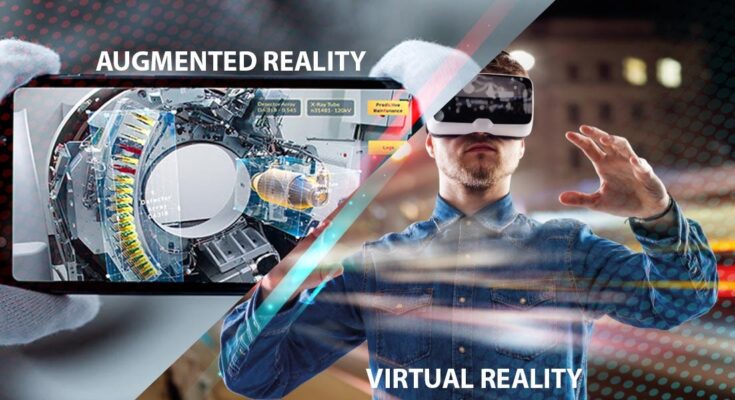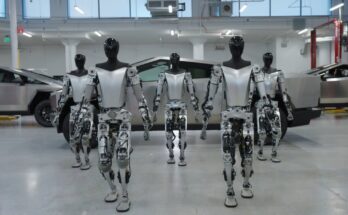In today’s fast-paced digital landscape, businesses are constantly seeking innovative ways to stand out and engage customers. Augmented Reality (AR) and Virtual Reality (VR) are at the forefront of this evolution, offering immersive experiences that captivate audiences like never before. This blog explores how AR and VR impact modern businesses, providing valuable insights for tech enthusiasts, business owners, and marketers.
Introduction to AR and VR: Definitions and History
Augmented Reality (AR) and Virtual Reality (VR) might sound futuristic, but their roots trace back several decades. Understanding their definitions and histories can help us appreciate their current applications.
What is Augmented Reality (AR)?
AR overlays digital information onto the real world. Think of Pokémon GO, where virtual characters appeared in physical surroundings. AR enhances users’ perception of reality through smartphones, tablets, or AR glasses.
What is Virtual Reality (VR)?
VR, on the other hand, creates entirely immersive digital environments. Using VR headsets, users can explore and interact with three-dimensional worlds. From gaming to virtual tours, VR offers experiences that feel incredibly real.
A Brief History of AR and VR
The concept of VR dates back to the 1960s with Morton Heilig’s Sensorama. However, it wasn’t until the development of computer graphics in the 1980s that VR began to take shape. AR’s origins can be traced to the 1990s when researchers developed heads-up displays for pilots. Fast forward to the 21st century, and both technologies have advanced significantly, finding applications across various sectors.
The Current State of AR and VR Technologies
AR and VR technologies have come a long way, making significant strides in both accessibility and functionality. Let’s explore the current landscape of these groundbreaking innovations.
AR and VR Devices
AR and VR devices have become more sophisticated and affordable. AR can be experienced through smartphones and tablets, while VR headsets like Oculus Rift and HTC Vive offer immersive experiences. These devices are now more accessible to consumers and businesses alike.
Software Advancements
Software development has played a crucial role in advancing AR and VR. Platforms like Unity and Unreal Engine allow developers to create intricate virtual worlds and AR applications. Additionally, AI integration has enhanced the capabilities of these technologies.
Market Growth
The market for AR and VR is booming. According to Statista, the global AR and VR market size was valued at $18.8 billion in 2020 and is expected to reach $209.2 billion by 2022. This rapid growth underscores the increasing adoption of these technologies across various industries.
The Impact of AR and VR on Consumer Experience
AR and VR are revolutionizing the way consumers interact with products and services. Let’s look at how these technologies enhance customer experiences.
Enhanced Shopping Experiences
Retailers are using AR to create interactive shopping experiences. For instance, IKEA’s AR app allows customers to visualize furniture in their homes before making a purchase. Similarly, beauty brands like Sephora offer AR try-ons, enabling customers to see how products look on them virtually.
Virtual Tours and Demos
In real estate, VR allows potential buyers to take virtual tours of properties without leaving their homes. This not only saves time but also provides a more immersive understanding of the property. Automotive companies are also leveraging VR to offer virtual test drives, giving customers a feel of the vehicle before visiting the showroom.
Entertainment and Gaming
The entertainment industry has seen a significant impact from VR. From immersive gaming experiences to virtual concerts, VR offers new ways for consumers to engage with content. For example, platforms like VRChat enable users to socialize in virtual worlds, creating unique and memorable interactions.
AR and VR in Business Operations
AR and VR are not limited to enhancing consumer experiences; they are also transforming business operations. Here are some case studies and benefits of these technologies in various industries.
Retail Industry
AR and VR are helping retailers streamline their operations. For example, Walmart uses VR to train employees, allowing them to practice real-world scenarios in a safe environment. This training method has shown to improve employee performance and reduce training costs.
Real Estate Industry
Real estate companies are leveraging VR to showcase properties to potential buyers worldwide. Matterport’s VR platform enables real estate agents to create 3D models of properties, providing a virtual walkthrough for clients. This not only expands the reach of property listings but also enhances the buying experience.
Entertainment Industry
In the entertainment sector, AR and VR are used for content creation and distribution. For instance, filmmakers use VR to create immersive storytelling experiences. Additionally, AR is being used in live events to enhance audience engagement, such as AR-powered concert visuals.
Overcoming the Challenges of Implementing AR and VR
While AR and VR offer numerous benefits, implementing these technologies comes with its own set of challenges. Let’s explore how businesses can overcome these hurdles.
High Initial Costs
One of the primary challenges is the high initial cost of AR and VR technology. Businesses need to invest in hardware, software, and skilled personnel. However, the long-term benefits often outweigh the initial investment. Additionally, as the technology becomes more mainstream, costs are expected to decrease.
Technical Expertise
Implementing AR and VR requires technical expertise. Businesses may need to hire developers and designers who specialize in these technologies. Partnering with AR and VR development firms can also provide the necessary expertise to ensure successful implementation.
User Adoption
Ensuring user adoption can be challenging, especially if the target audience is not tech-savvy. Businesses need to focus on user-friendly interfaces and provide adequate training and support to help users become comfortable with the technology.
The Future of AR and VR: Trends and Predictions
The future of AR and VR is bright, with several trends and predictions indicating continued growth and innovation. Here are some key trends to watch out for.
Increased Integration with AI
AI and machine learning will play a significant role in the future of AR and VR. AI can enhance the capabilities of these technologies by providing more personalized and interactive experiences. For example, AI-powered chatbots in VR environments can offer real-time assistance to users.
Expansion into New Industries
AR and VR are expected to expand into new industries beyond retail, real estate, and entertainment. Healthcare, education, and manufacturing are some sectors that are likely to see increased adoption of these technologies. For instance, VR can be used for surgical simulations, while AR can assist in remote maintenance and repair tasks.
Improved Accessibility
Accessibility will be a key focus in the future. Developers are working on making AR and VR devices more affordable and user-friendly. Additionally, efforts are being made to ensure these technologies are accessible to individuals with disabilities, further broadening their reach.
How Businesses Can Leverage AR and VR for Growth
To stay competitive, businesses need to leverage AR and VR effectively. Here are some strategies to help businesses harness the power of these technologies for growth.
Identify Relevant Use Cases
Businesses should start by identifying relevant use cases for AR and VR. Understanding how these technologies can address specific business challenges or enhance customer experiences is crucial. Conducting market research and analyzing competitors can provide valuable insights.
Invest in Training and Development
Investing in training and development is essential for successful implementation. Businesses should provide training for employees to ensure they are comfortable using AR and VR tools. Additionally, investing in the development of new AR and VR applications can help businesses stay ahead of the curve.
Collaborate with Experts
Collaborating with AR and VR experts can provide the necessary expertise for successful implementation. Partnering with development firms or hiring specialized personnel can help businesses overcome technical challenges and ensure the technology is used effectively.
Conclusion
AR and VR are transforming modern businesses, offering new ways to engage customers and streamline operations. By understanding the current state of these technologies, overcoming implementation challenges, and leveraging their potential, businesses can position themselves for growth and success.
For businesses looking to stay ahead, it’s time to explore the possibilities of AR and VR. Start by identifying relevant use cases, investing in training, and collaborating with experts. The future is immersive, and those who adapt will thrive.


